It wasn't easy.
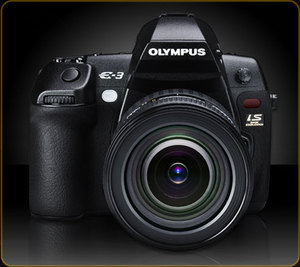


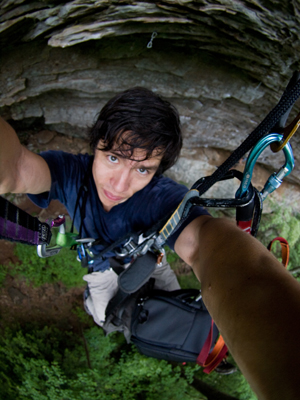
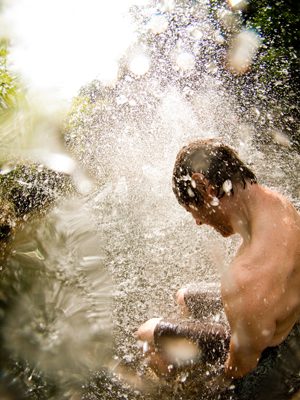
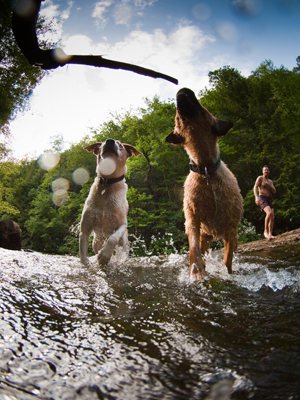
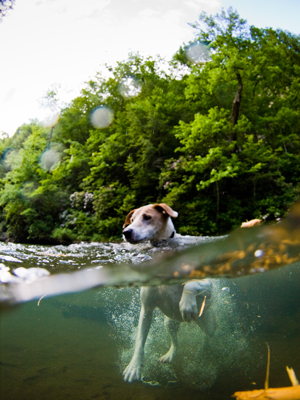
I had a chance to try out an Olympus E-3 DSLR for a while last month. Among other things, the magnesium E-3 body and Olympus Zukio lenses are known for their ruggedness. The whole system is billed as "splashproof and dustproof". The 10MP camera has been out for awhile, but it has a ton of other attractive features: in-camera image stabilization, automatic sensor dust cleaning, a built-in flash, live view, and the speed and responsiveness you would expect from a modern DSLR.

It was perfect timing because I had some climbing shoots lined up at some new areas near Chattanooga, Tennessee, and the conditions were perfect for this camera: rain for a solid week.
The thing about climbing in the south is that much of the walls are steep enough to allow climbing in even a downpour. If you are willing to hike out in the conditions, chances are you can climb dry rock once you get there. Still, tromping around and rigging ropes in the rain is usually hard enough on cameras to call off a day - or week - of climbing photography.
I was hoping the E-3 would live up to its reputation, and I could salvage an otherwise unproductive week of shooting.
The Zukio lenses are all fantastic. The build and optical quality is at least as good if not better than any DSLR system out there. I tested out four pro-quality lenses: The 8mm f/3.5 fisheye, 35-100mm f/2.0, 50mm f/2.0, and 300mm f/2.8.
Olympus has committed to the Four-Thirds sensor on all its DSLRs. This is a smaller sensor than the "cropped" APS sensor of Nikon and Canon, and has an aspect ratio that is closer to square than rectangular. The Olympus sensor and processor has a reputation for great color and image quality, and it's definitely not hype. I shot some portraits and kids in the neighborhood before heading up to Chattanooga, and the color and skin tones were remarkable, right out of the box, on auto white balance. I was looking forward to seeing what I could do to this camera in harsher conditions.

The climbing areas we explored over the next few days - which shall remain nameless - were deep, and rugged, and beautiful. In classic southern style, access involved 4WD roads, river crossings and long hikes in the rain. In these conditions I would normally keep my camera in a housing, or just leave it in the bag, but with the E-3, I could shoot and even change lenses with impunity. I spent a good part of one afternoon 80 feet in the air on a rope, under a small waterfall and light rain. Nothing seemed to give the camera pause. Not only that, but yielded great shots the whole time.


By the end of our trip I was getting ... reckless. We explored a river under one cliff
and the fun began.
Splash

Splash

Dunk

Uh, Oh!
That last shot was probably the camera's last shot, ever*. The E-3 is obviously not an underwater camera, and it's not meant to withstand immersion, but before it died I DID get a good number of "underwater" shots. Not many cameras would have inspired me to go for a shot like that... I think gear that can encourage you to take your craft one step further - thats money!
Olympus just released a new mini four-thirds camera, the E-P1, and its gotten a lot of attention, but with the excellent Zukio lens lineup, and the features the E-3 already has, I'm excited to see what Olympus has on deck for its next flagship DSLR.
I'd love to break it in!
* Note: I've learned that the camera actually survived and is happily taking pictures somewhere in Aruba. Guess it really isn't that easy.
Trackbacks
Listed below are links to blogs that reference this entry:
How to break an Olympus E-3*
. TrackBack URL for this entry:
http://theblindmonkey.com/darkroom/mt/mt-tb.cgi/24
Comments


So that's the half & half shot you were telling me about. That's awesome, almost as awesome as being allowed to destroy a camera! :)
(08.13.09 @ 10:49 AM)That's amazing! I honestly never expected such great results from an Olympus (I generally avoid products from companies other than nikon and canon because of a few previous experiences). I'm curious to learn what your rig is when you are photographing on a rope - something that has given me headaches (and leg pains) time after time. thanks
(08.14.09 @ 01:47 PM)Thanks Michael - My rig is usually pretty simple - on a single statc line, a Petzl GriGri and Ascender are the basic components, along with a good beefy wall or rescue harness (Petzl makes some great ones) and a Black Diamond 5-step etrier. Rig the ascender (which is leashed to you) above you, attach the etriers to the ascender, GriGri at your harness, pull in on the GriGri while you step up in the etriers, repeat. I like this setyup because it uses minimal gear and you can lower quickly. It's not the most efficient setup - you can increase the efficiency with a pulley at the Ascender - but with practice (and fitness) you can go pretty quick on this.
Maybe a video demonstration is in order - stay tuned.
(08.14.09 @ 03:10 PM)I actually own an E-3 recently took to Morocco, I agree is rugged but I actually felt that at 54C or 138F the autofocus was a little slower..
(09.01.09 @ 12:25 PM)They're Zuiko lenses, not zukio and the E-P1 is part of micro Four-Thirds, not mini unless of course, you just meant small. ;-)
No, you're not supposed to put the equipment underwater, but after shooting outside in 3 hurricanes, I can attest to the weatherproofing.
(09.04.09 @ 02:08 PM)Superbes images inspirées et qui montre le potentiel d'un E3
(09.05.09 @ 01:50 AM)Just discovered your blog - great reading. That last shot of the dog is fantastic - almost worth trashing the camera for!
(09.12.09 @ 09:10 AM)Fantastic shots! Very courageous to use your camera like that, but I'd say the images are worth it! What about the lens?!
Cheers
(09.14.09 @ 02:39 PM)Bruno
bousozoku: Thanks for the spellcheck.
I'd love to see your photos from shooting during a hurricane!
(09.14.09 @ 03:03 PM)Thanks Bruno - The lens was fine, no fogging or anything afterwards. They are all weather sealed to a high degree.
(09.14.09 @ 03:08 PM)